The chest of drawers is one of the most essential pieces of furniture in any home, found in all interiors whether they have a preference for an ornate antique or a contemporary design. Also known as a bureau or dresser, cabinets which include stacks of drawers may be more vulnerable to damage than other household items – this is due to frequent usage and a mechanism or fitting which may be prone to deterioration, breakage or warping over time.
 Above: drawers in our studio – before and after restoration by our talented furniture experts
Above: drawers in our studio – before and after restoration by our talented furniture experts
At Fine Art Restoration Company our furniture experts specialise in the repair and conservation of both modern and antique chests of drawers, using techniques and materials which are historically accurate to the design of the piece. This article will cover the many types of antique drawers you may come across, as well as the simple ways in which they can be appropriately cared for and how typical damages can be professionally restored.
 Above: examples of antique dressers, including late 18th century chests (left and centre) and high chest from the late 17th or early 18th century (right)
Above: examples of antique dressers, including late 18th century chests (left and centre) and high chest from the late 17th or early 18th century (right)
Dating a chest of drawers
It was the Victorians who popularised the chest of drawers as a vital piece of bedroom furniture, not only was this a helpful storage device, but a finely made and solidly built dresser was a sign of upward mobility in the growing number of middle class households. Many drawer cabinets you may come across in an auction house today will be from this influential 19th century period when manufacturing was more plentiful and many more designs were made commercially available.
 Above: an illustration of a bedroom in the 1820s featuring two sets of drawers, a writing desk and a wardrobe
Above: an illustration of a bedroom in the 1820s featuring two sets of drawers, a writing desk and a wardrobe
Prior to the industrial age, a chest of drawers would have evolved in design from a simple chest, as was commonplace in homes from the mediaeval era onwards for the storage of clothes and fresh linen. You can learn more about antique chests here. Whilst the oldest example of a chest of drawers can be dated back to a Han Dynasty physician’s cabinet in China, in Europe the rise of this type of furniture began in the 17th century. During the 17th and 18th centuries, a chest of drawers would have been an exclusive piece of furniture for the upper classes and royalty, but this was not entirely due to the cost – it was more so a matter of not having enough possessions worthy of so many drawers for storage. The number of drawers spoke to the many pieces of clothing or fine linen a person may own, thus hinting at status in society and wealth.
 Above: two examples of a chest with drawers from the mid to late 17th century featuring oak, pine and maple
Above: two examples of a chest with drawers from the mid to late 17th century featuring oak, pine and maple
Early examples of dressers were very tall, often with at least four tiers of drawers. A good indication of age is that 17th century drawers were not always as deep as the chest itself, leaving a few inches at the back, and the topmost drawers may have been slimmer in design than those below. Some examples may be very ornate with wooden appliques or carving, the vast majority will have a lock for every drawer and brass drop handles (though these may have been removed or broken over the course of their life). The majority of drawers from this period were made of oak.
 Above: an early 18th century high chest of drawers with decoration known as japanning (left) and a chest of drawers attributed to William Vile from the 1750s (right)
Above: an early 18th century high chest of drawers with decoration known as japanning (left) and a chest of drawers attributed to William Vile from the 1750s (right)
During the 18th century the chest of drawers remained in keeping with their baroque surroundings, as well as beautiful veneer work, they may also feature marquetry and inlays as part of their decorative design. Most British dressers would have heavily featured walnut, either solid or more commonly found in the veneer. When walnut became more scarce later in the century, it may have been substituted with mahogany. The base of veneer work was popularly oak with pine used for the interior elements. Raised curved edges may surround the drawers so that they do not expose the edges of the veneer. The bow front, which is a curved front, to a chest of drawers was also developed in this period.
 Above: 18th century commodes dating to the 1740s – designed by Charles Cressent and Bernard II van Risenburgh with marble tops and gilding (marble and gold leaf can also be restored in our studio)
Above: 18th century commodes dating to the 1740s – designed by Charles Cressent and Bernard II van Risenburgh with marble tops and gilding (marble and gold leaf can also be restored in our studio)
In the early 19th century, you may come across aspects of neoclassical design and regency era favourites such as a birds-eye maple veneer. The easiest way to tell apart 19th century furniture from those of an earlier period is in the development of technology, for example, the veneers became thinner as the century progressed due to machine cutting. They may have also been steamed and clamped into a shape to form a rounded edge or corner. Often decoration was passed over in favour of flat surfaces suitable for french polishing. Although timber from the previous centuries may still be found in these designs, the commercial aspect of furniture saw an increase in the amount of pine chest of drawers being manufactured for a mass audience, pine was cheap and easily crafted – it could either be coated in a veneer of more expensive wood or stained to mimic mahogany, oak, or exotic varieties beneath a glossy finish.
 Above: examples of 19th century chest of drawers including a regency dresser with neoclassical pillars, a Japanese inspired chest from 1881 and a dressing bureau from 1844
Above: examples of 19th century chest of drawers including a regency dresser with neoclassical pillars, a Japanese inspired chest from 1881 and a dressing bureau from 1844
For more information on the history of furniture and the changing styles which you can identify, please read our in-depth article here.
Popular styles
Two of the most popular furniture styles in the 18th century and early 19th century were influenced by two designers, Thomas Chippendale and Thomas Sheraton. Chippendale published an influential book in 1754 called ‘The Gentleman and Cabinet Maker’s Director’ which dictated many of the most fashionable styles, from ornate baroque and rococo designs through to neoclassicism and an oriental influence in chinoiserie. The Sheraton style was based on Thomas Sheraton’s book The Cabinet Dictionary from 1803, heavily influenced by the Louis XVI style; it also included inlays of satinwood, tulipwood, sycamore and rosewood.
 Above: two mid 18th century designs by Thomas Chippendale for a chest of drawers
Above: two mid 18th century designs by Thomas Chippendale for a chest of drawers
You may come across many revival styles dated to the Victorian era, especially those which mimic gothic or Tudor designs and those from the early 17th century. Sometimes they may even feature salvaged pieces from older chests. It is possible that antique chests have been cut down overtime to fit within smaller modern homes – a telling feature of this downsizing is that the handles seem closer to the exterior than usual.
 Above: original brassware and makers marks should be preserved to maintain the value and historic integrity of the design, this chest of drawers is from 1772 and has impressive surviving features
Above: original brassware and makers marks should be preserved to maintain the value and historic integrity of the design, this chest of drawers is from 1772 and has impressive surviving features
Serpentine and bow-fronted dressers are also frequently found in antique shops, these chests of drawers can both be dated to the 18th century but some revival designs may be masquerading and in fact be Victorian or turn of the century. Serpentine chests can be dated to the 1730s, these have a waved front that has been cut from a single piece of wood. They usually have up to four drawers and may feature a pull-out surface for writing to double as a small desk. The bow front was developed thirty years later and was often designed specifically to be ‘gentlemen’s furniture’ with a more masculine appeal, the feet were often squared or at a slight angle away from the chest. Later versions of a bow-fronted dresser may feature 2 smaller drawers at the top rather than 4 of an equal size, and by the 1830s they may have featured 5 levels of drawers. You can tell the age of a bow fronted or serpentine chest by looking at the way in which the wood has been shaped into a wave, a continuous piece of timber is likely the result of steaming which was a 19th century development.
 Above: serpentine chests have a wave to the front of the drawers
Above: serpentine chests have a wave to the front of the drawers
Caring for your chest of drawers
Wooden furniture of all kinds may face issues from the environment over time, that is the levels of humidity in the air and the fluctuation of temperatures in a room. It should be kept in mind that antique chests may have been kept in naturally ventilated and unheated rooms for hundreds of years, and the introduction of central heating may deteriorate their structure over just a few winters. And whilst high humidity may cause warping, a very dry atmosphere can also cause the timber to splinter and distort. These issues may severely affect a chest of drawers which requires precise positioning of the panels to open and close with ease, as well as remaining secure for the safe holding clothes and other possessions.
 Above: damage to a chest of drawers following a flood, this can be seen on the left of the furniture opposed to the original finish on the right
Above: damage to a chest of drawers following a flood, this can be seen on the left of the furniture opposed to the original finish on the right
Due to these common environmental problems, a dresser should always be positioned away from a heat source in a room. A humidifier that allows you to control the percentage in the atmosphere may also help to keep the wood at the correct level of moisture when central heating is on. Wooden furniture of the antique variety benefits from around 50% relative humidity. Further to the position of the chest, take note of the amount of sunlight in the room and avoid strong rays which may fade an original wood stain and allow a polished surface to unevenly perish over time.
An antique chest of drawers should be maintained with waxing and polishing, whether this is at home or professionally completed. You can find out more about furniture finishes and their care here. Waxing will help to prevent the severity of damage following spills and moisture, but if further staining occurs due to an accident our trained furniture experts can assist in a historically accurate restoration.
 Above: water staining and discolouration can be restored to the original finish by our experts
Above: water staining and discolouration can be restored to the original finish by our experts
Functional issues, such as sticking drawers that are difficult to open and close, should never be forced in or out of position. To avoid this worsening, a small amount of wax may help to smooth the sliding surface and protect the wood. If you are still encountering issues, our team can provide conservation appropriate repairs to allow them to glide easily again.
 Above: an example of woodworm damage to furniture, these small holes may encourage the pests to return and weaken the structure so benefit from being professionally sealed
Above: an example of woodworm damage to furniture, these small holes may encourage the pests to return and weaken the structure so benefit from being professionally sealed
As many older chests contain walnut and other vulnerable timber, woodworm may be a present or historic problem in the stability. If any evidence of small holes, especially those with dust surrounding them, should be seen by our professional team for swift eradication and the sealing of these gaps to prevent them from returning. Consider calling a pest removal expert to check the rest of your house to prevent these larvae from consuming further items.
Chest of drawers restoration
Our furniture experts often come across drawers that have either been damaged accidentally or through disasters such as floods, leaks or fires. Whether the damage has been devastating or is only a light mark to the surface, our team provides accurate care with consideration towards the age of the furniture.
 Above: a damaged chest of drawers before and after being repaired and stained by our furniture team with a historically accurate finish
Above: a damaged chest of drawers before and after being repaired and stained by our furniture team with a historically accurate finish
Restoration work commonly includes the removal of staining or watermarks, repairing lifting or broken veneers, resolving drawers that have become stuck or hard to use, and new finishes where required, such as french polishing, staining and waxing. Our furniture experts can also source historically appropriate pieces of timber and brass to replace lost areas. For more information on historically accurate furniture repairs, please click here.
In some cases our team can also restore alterations to an antique or modern piece of furniture, such as this chest of drawers which had been coated in white paint. It was sensitively removed before the original grain was strained and given a historically accurate finish.
 Above: a chest of drawers which had been previously altered and painted over, our experts removed this and restored the original woodgrain
Above: a chest of drawers which had been previously altered and painted over, our experts removed this and restored the original woodgrain
How can we help?
If you have a chest of drawers in need of professional care or restoration work, please contact our helpful team who will be happy to assist further.
To make contact please email us via [email protected] or call 0207 112 7576

 Above: drawers in our studio – before and after restoration by our talented furniture experts
Above: drawers in our studio – before and after restoration by our talented furniture experts  Above: examples of antique dressers, including late 18th century chests (left and centre) and high chest from the late 17th or early 18th century (right)
Above: examples of antique dressers, including late 18th century chests (left and centre) and high chest from the late 17th or early 18th century (right)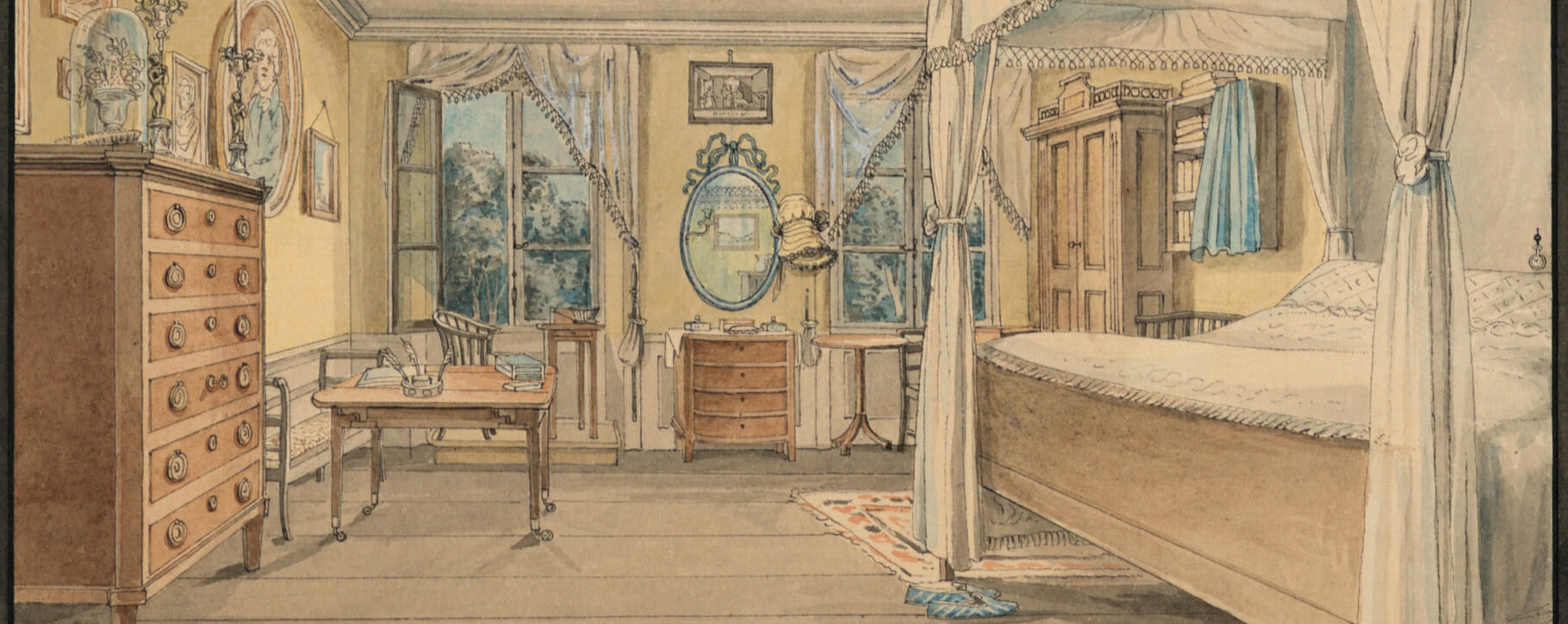 Above: an illustration of a bedroom in the 1820s featuring two sets of drawers, a writing desk and a wardrobe
Above: an illustration of a bedroom in the 1820s featuring two sets of drawers, a writing desk and a wardrobe 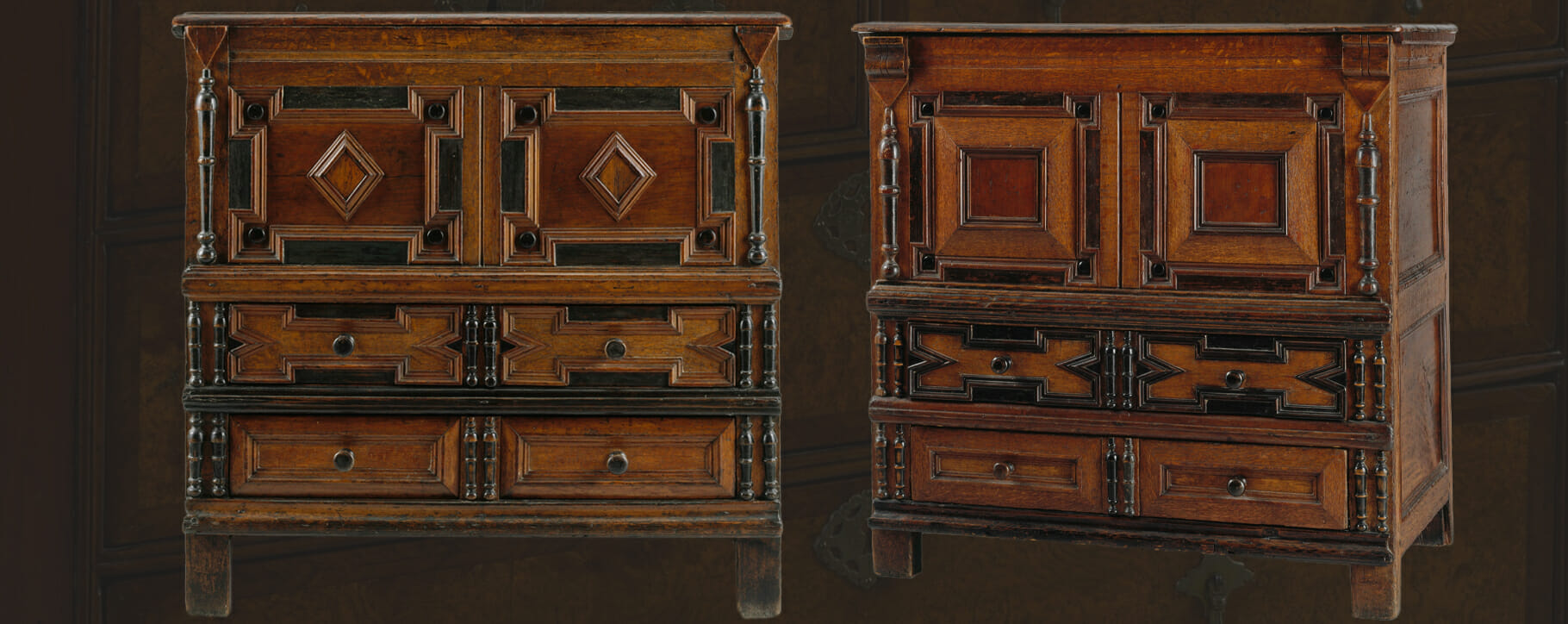 Above: two examples of a chest with drawers from the mid to late 17th century featuring oak, pine and maple
Above: two examples of a chest with drawers from the mid to late 17th century featuring oak, pine and maple  Above: an early 18th century high chest of drawers with decoration known as japanning (left) and a chest of drawers attributed to William Vile from the 1750s (right)
Above: an early 18th century high chest of drawers with decoration known as japanning (left) and a chest of drawers attributed to William Vile from the 1750s (right)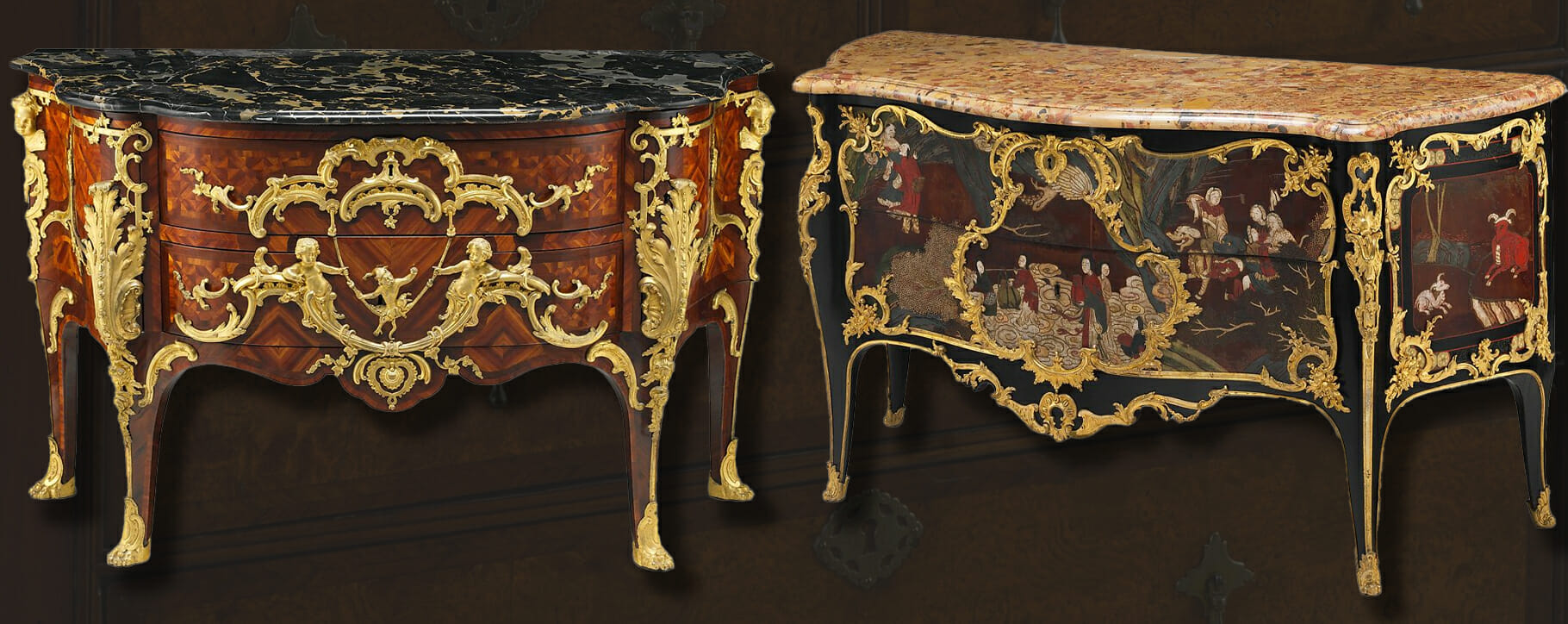 Above: 18th century commodes dating to the 1740s – designed by Charles Cressent and Bernard II van Risenburgh with marble tops and gilding (marble and gold leaf can also be restored in our studio)
Above: 18th century commodes dating to the 1740s – designed by Charles Cressent and Bernard II van Risenburgh with marble tops and gilding (marble and gold leaf can also be restored in our studio)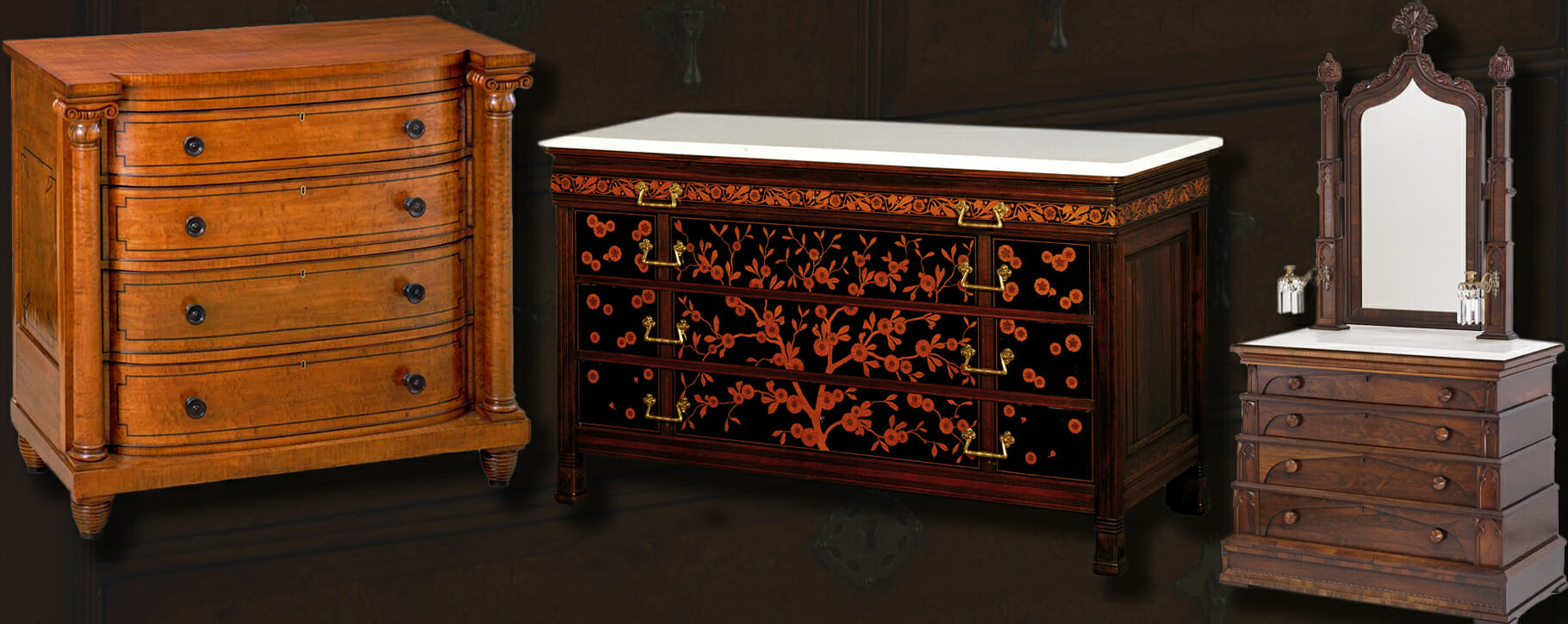 Above: examples of 19th century chest of drawers including a regency dresser with neoclassical pillars, a Japanese inspired chest from 1881 and a dressing bureau from 1844
Above: examples of 19th century chest of drawers including a regency dresser with neoclassical pillars, a Japanese inspired chest from 1881 and a dressing bureau from 1844 Above: two mid 18th century designs by Thomas Chippendale for a chest of drawers
Above: two mid 18th century designs by Thomas Chippendale for a chest of drawers Above: original brassware and makers marks should be preserved to maintain the value and historic integrity of the design, this chest of drawers is from 1772 and has impressive surviving features
Above: original brassware and makers marks should be preserved to maintain the value and historic integrity of the design, this chest of drawers is from 1772 and has impressive surviving features Above: serpentine chests have a wave to the front of the drawers
Above: serpentine chests have a wave to the front of the drawers Above: damage to a chest of drawers following a flood, this can be seen on the left of the furniture opposed to the original finish on the right
Above: damage to a chest of drawers following a flood, this can be seen on the left of the furniture opposed to the original finish on the right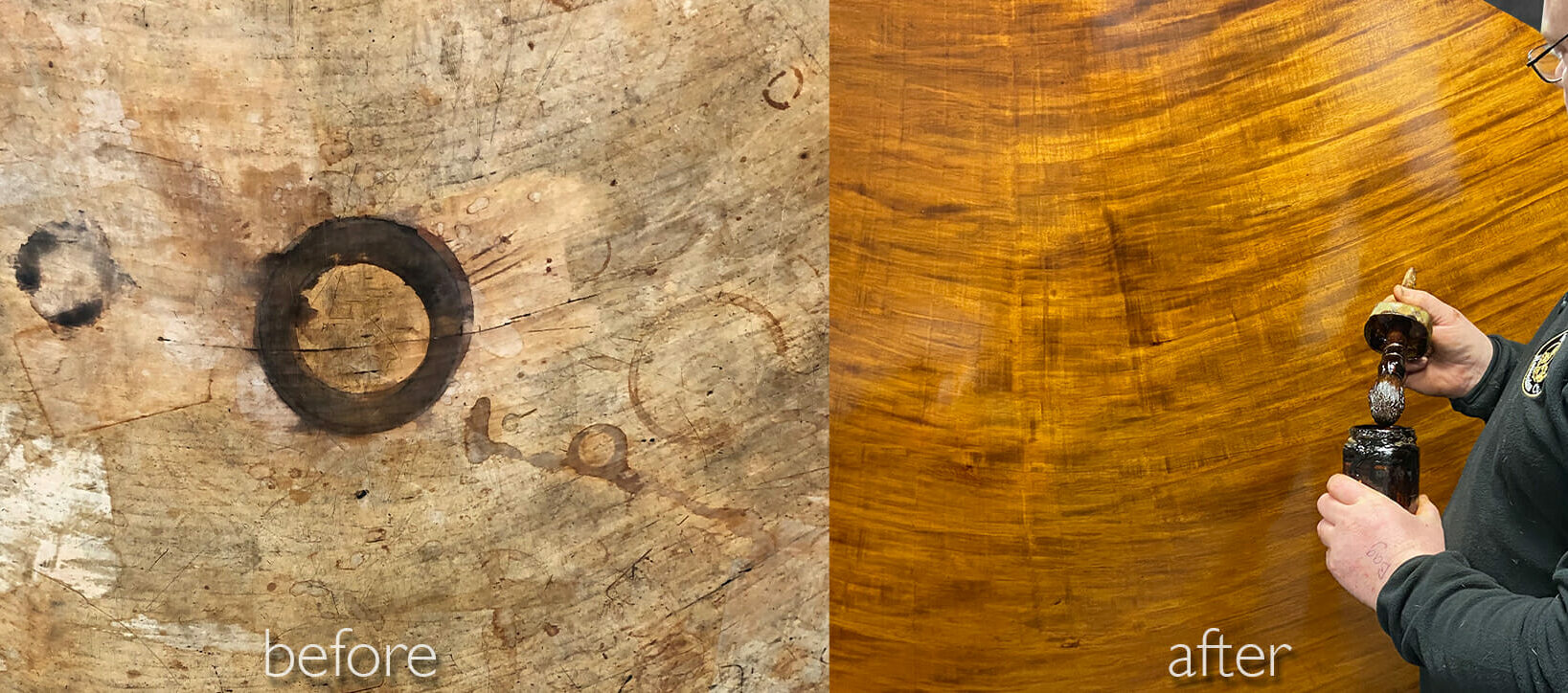 Above: water staining and discolouration can be restored to the original finish by our experts
Above: water staining and discolouration can be restored to the original finish by our experts  Above: an example of woodworm damage to furniture, these small holes may encourage the pests to return and weaken the structure so benefit from being professionally sealed
Above: an example of woodworm damage to furniture, these small holes may encourage the pests to return and weaken the structure so benefit from being professionally sealed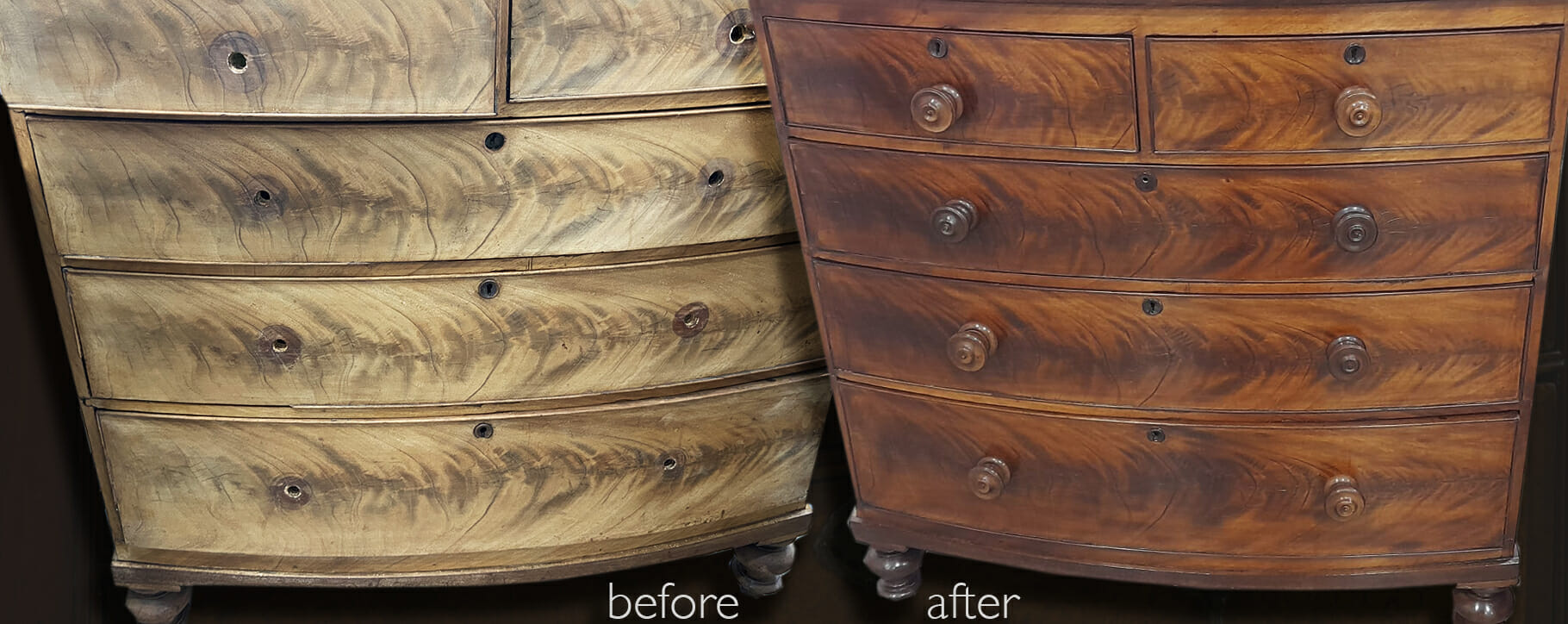 Above: a damaged chest of drawers before and after being repaired and stained by our furniture team with a historically accurate finish
Above: a damaged chest of drawers before and after being repaired and stained by our furniture team with a historically accurate finish Above: a chest of drawers which had been previously altered and painted over, our experts removed this and restored the original woodgrain
Above: a chest of drawers which had been previously altered and painted over, our experts removed this and restored the original woodgrain 




